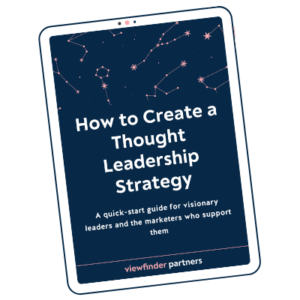Earlier this week, I talked to a new freelancer who has spent the past decade in corporate marketing. She wanted my advice on how to position herself and her services.
One of my immediate suggestions: Start a thought leadership practice. Force yourself to think about your work and reflect on what you’ve learned. Start “thinking in public.”
Silence on the other end of the phone. Then a deep sigh. “Yeah…I know I need to figure out how to create content.”
What I heard between the lines: “I have so much to do before I can get to a point where I can talk about my ideas and my work. I have to wait until I’m ready. [Insert distant milestone here].”
Most people shy away from a personal thought leadership practice. It can feel like a big, weighty, stressful undertaking that requires perfection, detailed planning, and, most of all, a willingness to perform. What if you don’t say the “right” thing? What if people disagree with you? What if you’re just plain wrong? What if you look stupid?
Anyone would feel tongue-tied when they put themselves under that kind of pressure.
So let me introduce a radically different way to approach thought leadership.
Thought leadership is about generosity, not ego
Thought leadership is not a performance that requires you to strut your stuff. It’s not a realm reserved for narcissists and people with outsized egos. It’s not just for people who have “made it” and already have an eager audience.
Nope.
Thought leadership is an act of generosity. It’s an interactive, thoughtful process of reflecting on your work, what you’ve learned, how your perspective has changed, and what you’re curious about. It’s letting people in to your decision-making process, your scratchpad, your learning process. It’s not a role you need to play. It’s just opening up about what you’re already working on and letting people see your thoughts.
Thought leadership starts with thinking about your work
If you’re stuck on saying the “right” thing, try reframing your mindset about thought leadership.
Thought leadership = thinking about your work so other people can see it.
THINKING about your work. That’s all it is. And you can do that right now without any official credentials or a PR team.
You don’t need to Act Like a Thought Leader or present some perfect, polished persona. Instead, think smaller. Your job is to reflect on your work, notice patterns, and explore themes you’re seeing.
When you start thinking this way, thought leadership becomes much more approachable. Your “content” will also be much more authentic and interesting.
6 examples of thought leaders (people who are generously thinking out loud)
Looking for examples of generous people sharing their ideas about their work? I pulled some examples from the wild to show that no matter how much experience you have, what field you work in, or how big your company is, you can generously think out loud about your work. You can start your own thought leadership practice. Some of these people I know personally; some I found by going down rabbit holes in niche industries.
Founders
When most people think about thought leaders, they think about visionary founders—people who had a big idea and started something new. But it’s shocking to me how few of the world’s visionary founders have a thought leadership practice. What are they working on? How has their big idea evolved? No one outside of their immediate circle knows; they’ve closed their thought process into a black box.
Brea Starmer, Founder and CEO of Lions & Tigers, is an excellent example of a visionary founder who *shows her work* by consistently thinking in public. Here’s an example from her LinkedIn profile. She shares what she’s working on and the thought process behind it. She’s open and generous. If you need inspiration, follow Brea.
C-Suite Leaders
If you’ve made it to a top leadership role in an organization, you definitely have experience making tough decisions and explaining your thought process to other people. If you’re brave enough to share that thought process with people outside your immediate colleagues, congratulations! You’re doing the generous work of thought leadership.
Thasundra Brown Duckett is President and CEO at TIAA, a financial services institution founded by Andrew Carnegie in 1918. If the leader of an organization with deep historical roots in a tightly regulated field like financial services can share her thinking in public, so can you.
When I scrolled through her LinkedIn feed, I noted that she’s not just sharing sanitized “ads and accolades” (the safe marketing promotions focused on the brand) that we’re used to seeing from CEOs. Instead, she’s sharing book recommendations, making bold calls to action, and talking about the *feelings* behind financial decisions.
Years ago, I saw serial CMO Jackie Yeaney speak at a marketing conference. She was an incredible speaker because she was generous and candid and shared a peek into her work. At the time, she was a marketing leader at Red Hat. I’ve followed her for years and she continually impresses me with her thinking and her leadership.
She built her thought leadership by speaking at events, sharing her experience on podcasts, and being active on LinkedIn.
Here’s an example of a conversation she had on a podcast for marketers. She shared not just *what* she was working on at the time but *how* she thinks and *why* she makes certain decisions.
Bonus example: Regina Bynote Jones, Sr Vice President, General Counsel & Corporate Secretary at food manufacturing company ADM— If a legal leader can candidly share her thinking, you can too.
Technical Leaders
Thought leadership isn’t just for marketers/consultants/entrepreneurs. Some of my favorite thought leadership comes from people with deep technical backgrounds. It’s challenging to talk about coding nurse staffing software or redesigning a supply chain without getting into industry jargon—or without giving away proprietary information.
Rachel Schiff is a developer-turned-product leader who has worked at Microsoft, Virgin Pulse, and the healthcare workforce management company IntelyCare. Here she is on a video interview explaining her approach to experimentation and collaboration between product and data science.
When you think “supply chain,” what’s the first thing that comes to mind?
For me, it’s definitely not “TED Talk,” but guess what I found on the TED YouTube channel? An approachable conversation about the state of supply chains with Dustin Burke, an operations expert at BCG.
I’m sharing this broad swath of thought leadership examples to show that all kinds of people can and do think in public about their work. Sure, some of them have marketing teams behind them. But the end results you’re seeing here didn’t just appear out of thin air. Each of these thought leaders has been engaged in the hard, messy practice of thinking in public for many years to get to this point.
Not sure how to start thinking about your work? Try these thought leadership prompts.
Now it’s your turn.
To build a thought leadership practice, the first step is to start thinking about your work. While everyone implicitly thinks about what they’re working on, thought leadership requires creating an explicit practice. Set aside a chunk of time (20 minutes on a Friday afternoon, for example) and reflect on one of these questions:
- What’s the most interesting thing you’re working on?
- What’s your favorite kind of project?
- What’s really hard right now?
- What’s something that you’ve seen change over the past few years?
- What do you wish people understood?
- What advice do you find yourself giving over and over?
- What’s something new you’re trying?
- What’s something you used to do that you’ve STOPPED doing?
- How would you explain your job to an elementary schooler?
Thought leadership isn’t a job for the big egos in the room. It’s a hard and messy practice for people willing to share how they think. If you can do that, you can be a thought leader, too.






